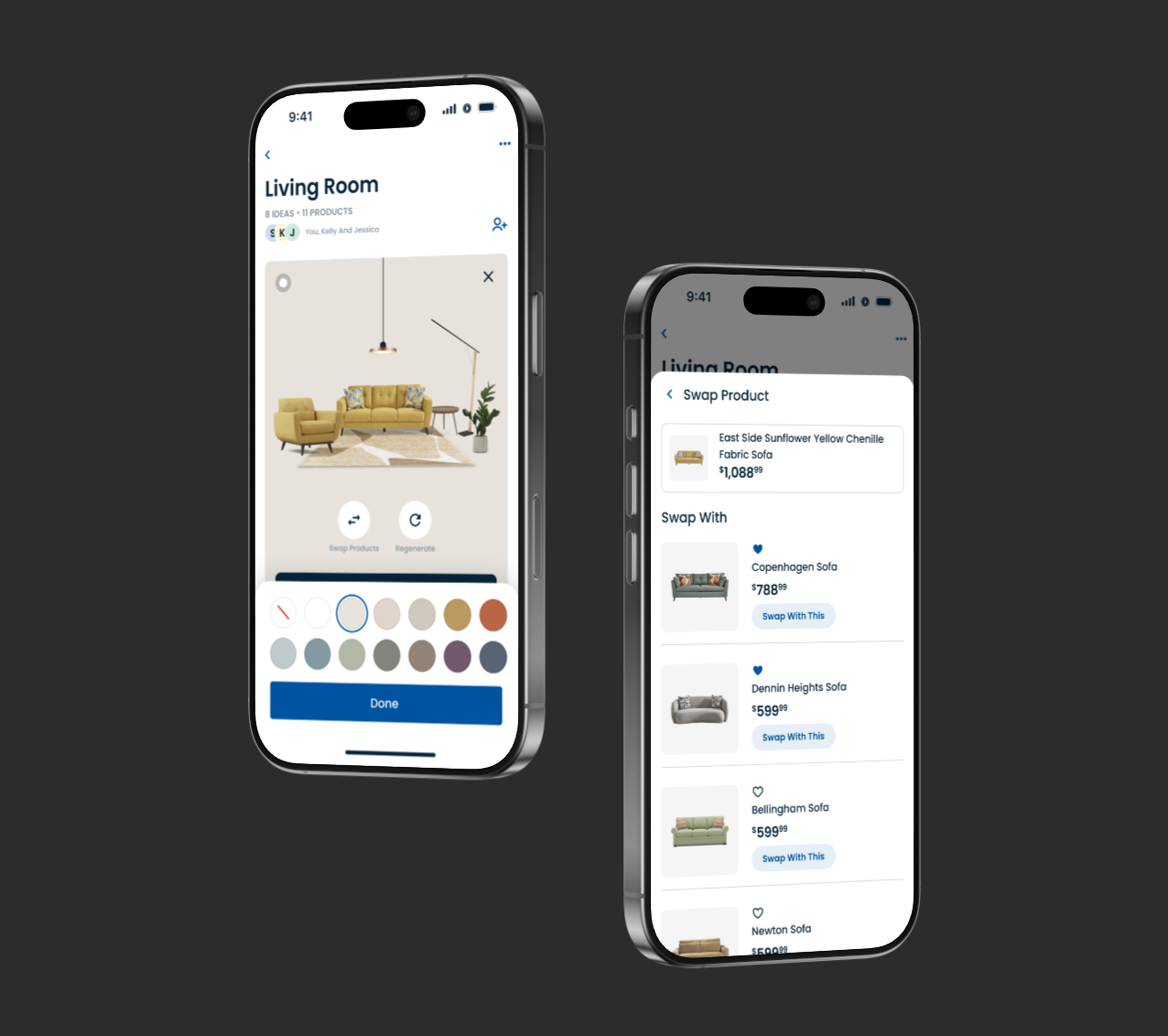Defining the Role of AI in a National Furniture Brand’s Digital Experience
ENTERPRISE FURNITURE BRAND
Explored and framed opportunities in visual search, personalization, AR, and conversational agents to elevate the room shopping journey across mobile, in-store, and digital touchpoints.
Exploring the Future of Furniture Discovery
This project began not with an existing problem to solve, but with an open-ended challenge: how might AI enhance the client’s retail app experience? We set out to explore how emerging AI capabilities could help customers navigate the complexities of furniture discovery in a more personalized, inspiring, and scalable way.
Defined the opportunity space and directional goals with stakeholders
Positioned AI to support both inspiration and purchase confidence
Outlined initial success criteria for discovery, usability, and trust
My Role
Principal Product Designer
Scope
Product Strategy, User Experience, Visual Direction, User Testing, Design Systems
Tools
Figma, FigJam, UserTesting.com
Cross-Industry Research on AI Tools
We began by looking beyond our category, studying how AI was being used in adjacent industries to uncover useful patterns and design metaphors. This helped frame what “smart” could feel like in a furniture shopping context.
Audited 12+ apps and tools across fashion, fitness, and interiors
Mapped use cases by AI behavior type (generation, personalization, recommendation)
Identified interaction patterns that could inspire low-friction entry points
Early Ideation & Concept Development
We turned our research into product hypotheses, exploring how intelligent tools could guide discovery without overwhelming the user. The concepts ranged in ambition, some simple and utility-driven, others more immersive and assistive.
Ideated 5 concept families with distinct AI roles (e.g., assist, auto-create, co-create)
Built early mobile mockups to visualize how each one would work in the app
Aligned with product and engineering on feasibility and impact
User Testing & Design Validation
We validated our AI concepts with real users to test comprehension, usefulness, and trust. The goal wasn’t just usability; we wanted to understand how confident and inspired people felt when interacting with various AI tools. We wanted to learn how people responded to system-generated suggestions and where they expected control, customization, or guidance.
Conducted moderated usability sessions with interactive prototypes
Observed and discussed how users responded to system-generated results and customization layers
Identified key moments where users expected to edit, explore, or override suggestions
Synthesized findings into a matrix of UX refinements and trust-building opportunities
Flow Mapping & Experience Systemization
Once we had directional clarity, we mapped the full end-to-end experience. This included integrating new entry points, handling edge cases, and extending the visual system to reflect the tool’s dynamic logic.
Defined user flows for first-time use, returning users, and fail states
Created modular screens that flexed based on user input and backend data
Updated visual system to accommodate AI-specific UI components and guidance cues
Final Testing & Design Delivery
After a second round of user testing confirmed the direction, we finalized the designs, documented the system updates, and delivered everything to the client—complete with flows, patterns, and annotations for integration into their existing design system. The outcome was a fully realized AI-assisted experience that fits naturally within the Clients mobile app while opening doors for future personalization at scale.
Shoppable Utility
We prioritized clear paths to action, allowing users to compare options, save favorites, and build custom room collections. The experience supports high-consideration purchases with features designed to reduce friction and encourage return visits.
Guided Exploration
From visual quizzes to curated collections, we reimagined how users browse. Instead of scrolling through categories, shoppers can explore by style, room type, or inspiration, making the process feel more personal and engaging.
The app reflects what customers see in-store. Sales, promotions, and delivery details are clearly surfaced, aligning digital with the showroom experience and supporting floor sales teams with consistent messaging and product availability.
Retail Alignment
Reflection
This project reinforced the power of practical UX paired with thoughtful design.
Delivering a feature as tangible as the Room Builder required balancing simplicity with inspiration, guided by real user feedback, business needs, and on-the-floor sales realities.
The most rewarding part? Seeing a tool that helps shoppers confidently visualize their space while also supporting in-store teams with better customer conversations.
3
Distinct product vision tracks developed to meet key business goals: in-store integration, self-service utility, and inspiration-driven browsing.
6
Future-forward feature concepts ranging from AI decor quizzes to AR room builders, UGC-style galleries, and smart post-purchase delivery tracking.
156M+
Estimated app market opportunity based on analysis of top competitors’ download volume used to support ASO and product roadmap prioritization.








